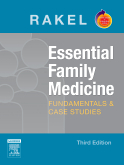Description
This textbook provides 46 case studies representing problems
frequently encountered in primary care. They are authored by family
physicians and are typical of patients seen in their practices. Each
case includes a table listing the Key Points presented. An evidence-
based grade is given to each reference.
Key Features
Provides evidence-based grade given to every reference with the
strength of evidence shown by a grade of either A, B, or C.
A table listing the Key Points or Pearls is included with each case
study.
New to this Edition
Case studies focus on the differential diagnosis of a presenting
symptom that can be the sign of a simple common problem or a complex
and potentially life-threatening disease.
The Relevance of Medical History to Medical Education is a unique
look at the importance of medical history to the education of health
professionals.
-Table of Contents-
Chapter 1 The Family Physician
Chapter 2 Ethics in Family Medicine
Chapter 3 Family Dynamics and Health
Chapter 4 Patient Compliance
Chapter 5 Disease Prevention
Chapter 6 The Consultation Process
Chapter 7 The Problem-Oriented Medical Record
Chapter 8 Problem Solving in Family Medicine
Chapter 9 Interpreting Laboratory Tests
Chapter 10 Selecting Radiographic Tests
Chapter 11 Managed Health Care
Chapter 12 Basics of Prescription Writing
Chapter 13 Immunizations
Chapter 14 Weight Loss and Diarrhea
Chapter 15 Chronic Cough
Chapter 16 Fever and Chest Pain
Chapter 17 Dyspnea
Chapter 18 Acute Bronchitis
Chapter 19 Blurring of Vision
Chapter 20 Ear Pain
Chapter 21 Sinus Congestion
Chapter 22 Dizziness
Chapter 23 Sore Throat
Chapter 24 Oral Leukoplakia
Chapter 25 Nasal Congestion
Chapter 26 Wheezing
Chapter 27 Diarrhea
Chapter 28 Pregnancy
Chapter 29 Newborn Care
Chapter 30 Hyperactivity
Chapter 31 Short Child
Chapter 32 Preschool Physical Examination
Chapter 33 Abdominal Pain
Chapter 34 Breast Lump
Chapter 35 Laceration Repair
Chapter 36 Vaginal Discharge
Chapter 37 Amenorrhea
Chapter 38 Postmenopausal Vaginal Bleeding
Chapter 39 Contraception
Chapter 40 The Abnormal Pap Smear
Chapter 41 Menopause
Chapter 42 Chest Pain
Chapter 43 Shortness of Breath
Chapter 44 Hypertension
Chapter 45 Hypercholesterolemia
Chapter 46 Atrial Fibrillation
Chapter 47 Knee Injury
Chapter 48 Neck Pain
Chapter 49 Shoulder Pain in a Recreational Athlete
Chapter 50 Elbow Pain
Chapter 51 Wrist and Hand Pain
Chapter 52 Lower Back Pain
Chapter 53 Ankle Injury
Chapter 54 Joint Pain and Stiffness
Chapter 55 Skin Papule
Chapter 56 Eczema
Chapter 57 Acne
Chapter 58 Rash and Fever
Chapter 59 Obesity
Chapter 60 Type II Diabetes
Chapter 61 Weight Loss
Chapter 62 Malnutrition in the Elderly
Chapter 63 Eating Disorders
Chapter 64 Heartburn
Chapter 65 Constipation
Chapter 66 Fatigue and Anemia
Chapter 67 Anemia
Chapter 68 Vomiting and Low Back Pain
Chapter 69 Hematuria
Chapter 70 Dysuria
Chapter 71 Nocturia
Chapter 72 Urinary Incontinence
Chapter 73 Headache
Chapter 74 Tremors
Chapter 75 Child with Fever and Lethargy
Chapter 76 Chronic Anxiety
Chapter 77 Sleep Disturbance
Chapter 78 Motor Vehicle Accident-Related Anxiety
Chapter 79 Domestic Violence
Chapter 80 Memory Loss
Chapter 81 Alcoholism
Chapter 82 Approaches to Patients Who Smoke
Chapter 83 Terminal Cancer and Pain


